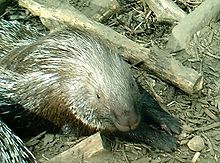Hystrix africaeaustralis
| Cape porcupine | |
|---|---|
 |
|
| Scientific classification | |
| Kingdom: | Animalia |
| Phylum: | Chordata |
| Class: | Mammalia |
| Order: | Rodentia |
| Family: | Hystricidae |
| Genus: | Hystrix |
| Subgenus: | Hystrix |
| Species: | H. africaeaustralis |
| Binomial name | |
|
Hystrix africaeaustralis Peters, 1852 |
|
The Cape porcupine or South African porcupine, (Hystrix africaeaustralis), is a species of Old World porcupine native to central and southern Africa.
Cape porcupines are the largest rodents in southern Africa and also the world's largest porcupines. They are similar in appearance to, and only slightly larger than, their close relatives, the crested porcupines, and can most easily be distinguished from them by the presence of a band of short white spines along the midline of the rump. Cape porcupines measure 63 to 81 centimetres (25 to 32 inches) long from the head to the base of the tail, with the tail adding a further 11–20 centimetres (4.3–7.9 inches). They weigh from 10 to 24 kilograms (22 to 53 pounds), with exceptionally large specimens weighing up to 30 kg (66 lb); males and females are not significantly different in size.
They are heavily built animals, with stocky bodies, short limbs, and an inconspicuous tail. The body is covered in long spines up to 5 centimetres (2.0 in) in length, interspersed with thicker, sharply pointed, defence quills up to 3 centimetres (1.2 in) long, and with bristly, blackish or brownish fur. The spines on the tail are hollow, and used to make a rattling sound to scare away predators. An erectile crest of long, bristly hairs runs from the top of the head down to the shoulders. The spines and quills cover the back and flanks of the animal, starting about a third of the way down the body, and continuing onto the tail. The quills have multiple bands of black and white along their length, and grow from regularly spaced grooves along the animal's body; each groove holding five to eight quills. The remainder of the animal, including the undersides, is covered with dark hair.
The eyes and ears are relatively small, and the mobile whiskers are short. The feet have five clawed toes, although the first toes on the forefeet are vestigial. Females have two pairs of teats.
Cape porcupines are found across the whole of southern and central Africa, to southern Kenya, Uganda, and Congo at the northern edge of their range. They inhabit a wide range of habitats, from sea level to 2,000 metres (6,600 ft), although they are only marginally present in dense forests and the driest of deserts, and are not found in swampland. There are no currently recognised subspecies.
...
Wikipedia

